DCS: AH-64D Apache - 25 years of Quality Evolution
The latest DCS simulator: AH-64D Apache brings back memories of classic games like Gunship and Longbow. This is a great example the tremendous progress in the quality of PC simulators that has been made over the decades.
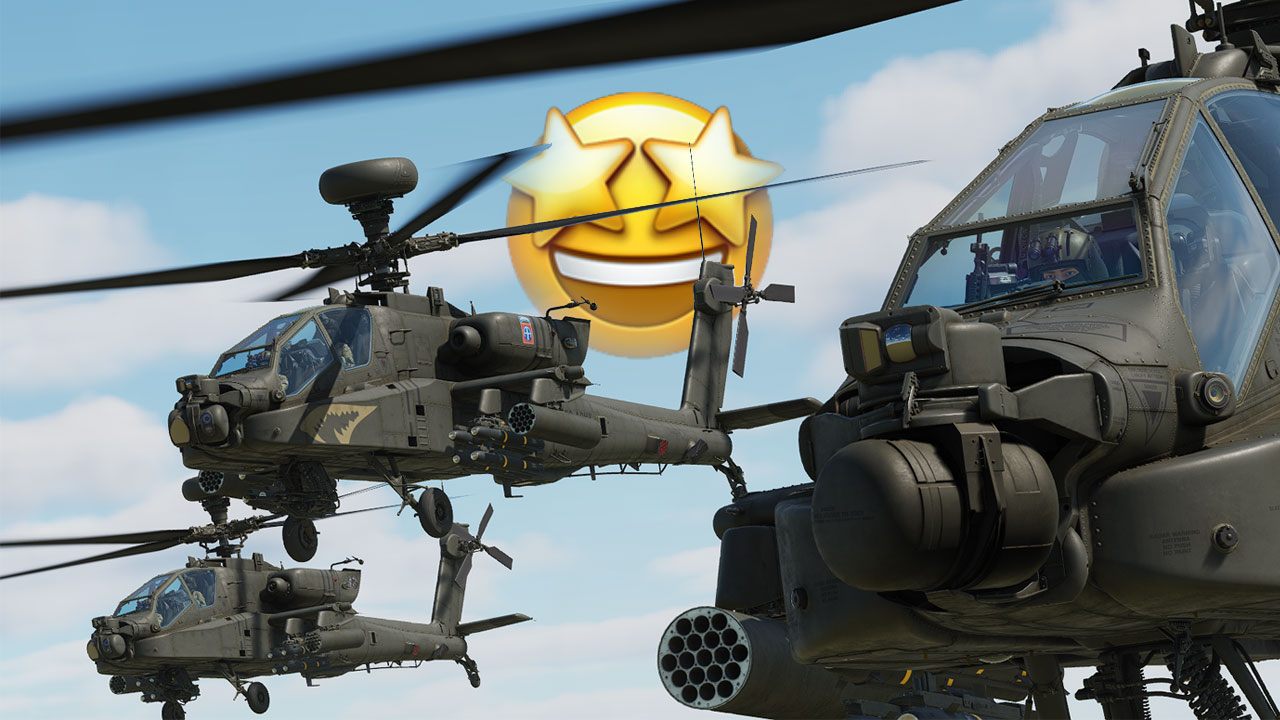
The heroes of these games were not only flesh-and-blood characters. I am also talking about charismatic robots and artificial intelligence systems, such as GLaDOS, Wheatley, BD-1 and a few other memorable "tins cans." These were also special-purpose machines – that's how it used to be in the times of the greatest popularity of flight simulators, when games about airplanes or helicopters won GOTY titles in the "action game" category. In a sense, they were FPP games set in huge sandboxes.
One of such "protagonists" was certainly the AH-64 Apache – a helicopter so famous that its shape and name are also recognized by laymen who are not really aviation passionates. This is partly due to TV coverage of the 1991 Gulf War, aka Operation Desert Storm, where the chopper played a very important role. But Apache also owes its iconic status to video games, as well as the spectacular, albeit overall rahter poor film Fire Birds, starring Nicolas Cage and Tommy Lee Jones. We have much better memories of the famous Gunship by Microprose and its sequel, and the realistic Jane's Longbow series by Electronic Arts.
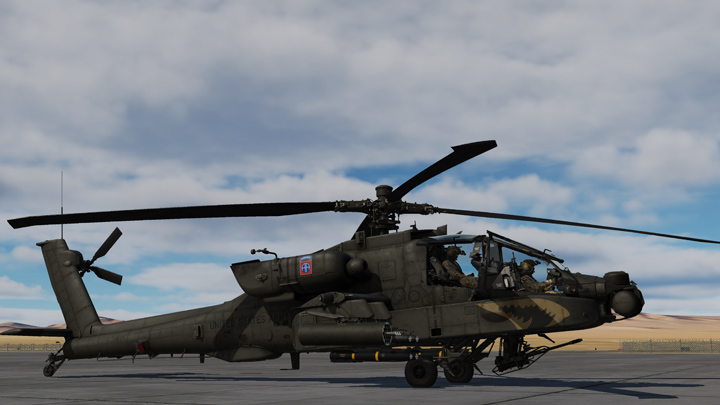
Now, as DCS: AH-64D Apache by Eagle Dynamics has just been released, it's a great opportunity to remind you about those older games. It's the most realistic, the most advanced helicopter simulator that can exist on the commercial market. You could say it's a spiritual heir to the Gunship and Longbow series, but at the same time, it's a kind of benchmark – an exhibition of what the simulator genre has achieved on PC. The release of the DCS: AH-64D is also a good opportunity to notice how the process of creating such games has changed and to appreciate the capabilities that we couldn't dream of back in the day – and it's not just about technical and hardware matters. First things first…
The first Apache was a Gunship
When in 1986 MicroProse and people like Sid Meier and Andy Hollis launched Gunship, the Apache helicopter was recognizable on the launch screen and in pre-mission settings, and the available weapons also made it clear. In the game proper, the Apache cockpit was only apparent by the characteristic arches of the frame. The appearance of the instruments was the invention of the developers, who were heavily limited by the graphics and resources of 8-bit computers at the time. After all, the team from MicroProse still managed to include a lot of realism in the game, including a destruction system and the autorotation effect during emergency landings, or the possibility of rearming and refueling at field bases.
Green Apache instead of Blue Thunder
Gunship was initially to be inspired by the atmosphere of a movie popular in the era, Blue Thunder, in which the "protagonist" was a police helicopter packed with electronics. The creators of Gunship wanted to depict similar operations of a pilot in an urban area, but the complex graphics of a virtual metropolis that would have to be created turned out too demanding for the capabilities of contemporary computers. So, the engine of the previous game (F-15 Strike Eagle) was used, and we received another military simulator focused on campaigns, incl. in the Middle East and Western Europe. The production was warmly welcomed and sold over 500,000 copies.
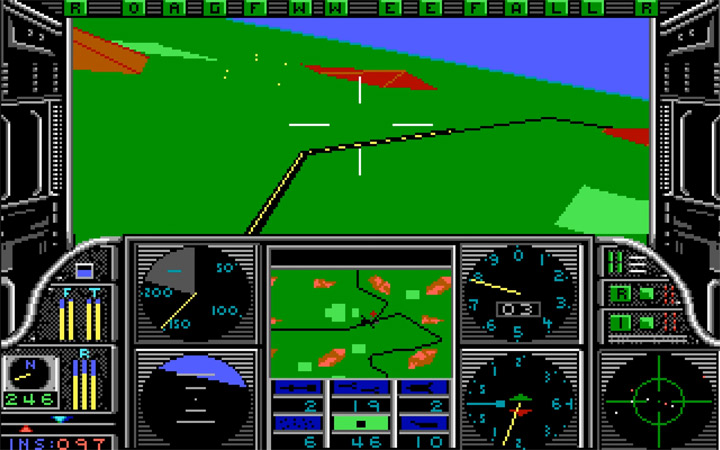
2000 times better – Gunship 2000
Released five years later, in 1991, the sequel Gunship 2000 already brought a significant revolution in the simulator genre. At first glance, the graphics quality was quite striking, as the game entered a completely different era of quality and performance with the advent of VGA and Amiga 500. The cockpit looked much more realistically, although the arrangement of the instruments was still determined by gameplay and the number of simulated systems, rather than reality. It also combined the responsibilities of the pilot and gunner on one screen, unlike in the real machine, operated by two people.
What's much more important, is the fact that the terrain was much more realistic, with varied topography, hills and valleys, which opened up some nice, realistic tactical capabilities, such as "pop-up" attacks, i.e. quickly emerging from behind a hill, or "nap-of-earth" flying – at very low altitude to avoid being detected by the radar. Gunship 2000 also introduced missions with wingmen who could be given orders. In addition to the AH-64 Apache, the game allowed to fly other helicopters: UH-60 Black Hawk, AH-1 Cobra, OH-58 Kiowa, MD-530, and RAH-66 Comanche. In such cases, the objectives of the mission were adapted to the roles of these machines; for example, the Black Hawk was used for transport.
There's a fun piece of trivia related to the completely unrealistic, rapid consumption of fuel by each of the helicopters in the game. It turned out that this was a safeguard the creators used to cover the relatively small area where you could fly. To complete a mission, refueling and rearming in field bases was required, and they were arranged so that you could not freely explore the entire area. Not only for this reason, Gunship 2000 was still more an action game than a simulator, which did not prevent it, even in the eyes of critics, from being considered the best helicopter sim of its time.
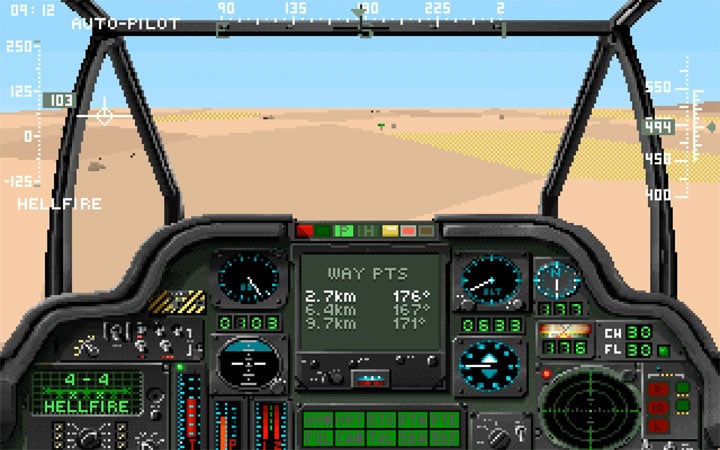
Competition that swept Gunship away!
MicroProse, after many perturbations and acquisition by Hasbro Interactive, tried to revive the legend of Gunship in the third part of the game – Gunship! – made in the year 2000. Unfortunately, this edition did not elevate the genre of simulators to a new level by any means. It was an ordinary air combat game, and a huge disappointment to the simulation fans. Suffice it to say that all take-off sequences were cut from the game – each mission started in the air and the power of the available weapons was somewhat exaggerated. It finally was possible to play as the gunner, but the artificial intelligence in control of the machine left a lot to be desired. Gunship! still delighted with graphic design – especially with fantastic terrain textures.
Perhaps the reception of the game would have been slightly different, if a different game had not appeared a few years earlier – Jane's AH-64D Longbow. During MicroProse's hiatus caused by internal troubles, Electronic Arts took over as leaders in the flight sim genre, and Longbow became a true role model.
Jane's AH-64D Longbow
If someone in the second half of the 90s wasn't very familiar with the world of video games, they would be forgiven for thinking that the best simulators of this time were created by the mysterious Jane's Combat Simulation company, whose logo graced the boxes of many iconic games. In fact, however, it was called Jane's Information Group – an extremely recognized company in the world, existing since the end of the 19th century, dealing with OSINT (open-source intelligence), that is, collecting publicly available information on military equipment and national security.
And it entered gaming thanks to Electronic Arts! The publisher simply acquired the rights to use this brand for several years to add credibility and (apparent) expertise to its growing portfolio of simulators. This is how Jane's Combat Simulation was created – it was a separate EA brand, managed by... Andy Hollis, an aviation simulator specialist who previously created the greatest hits of MicroProse, and Paul Grace – a sim creator at EA, responsible for such titles as 688 Attack Sub, LHX: Attack Chopper, or Seal Team.
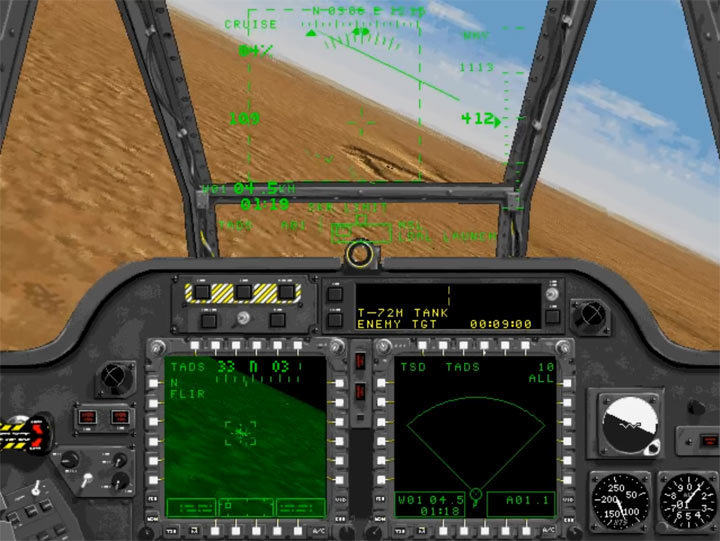
What's more, the team behind them was Origin Systems studio, creators of series like Ultima, Wing Commander, and hits like System Shock and Strike Commander – to name just a few. This dream team was behind Jane's AH-64D Longbow released in 1996 – the best Apache helicopter simulator of its time. Reviewers praised the visuals and a large selection of difficulty levels, including the most realistic ones, which took the flight model and avionics into account.
In training missions, the voiceover flooded the player with military jargon related to Apaches, such as: "TADS", "Bob-Up", "CP/G", "IHADSS." It was possible to take part in dozens of meticulously prepared missions – including historical scenarios in Panama and Iraq. The Flashpoint Korea expansion, released soon after, not only added a new theater of action, but also allowed us to finally play as gunner. Jane's AH-64D Longbow was a genuine simulator for hardcore players.
Any flaws of that game were removed in the sequel, Jane's Longbow 2, released very quickly, merely a year later. This time, the code ran only on Windows and harnessed the full power of the 3dfx graphics accelerator. Not only did it look great, but the team from Origin Systems also added a dynamic campaign, i.e. a series of missions generated according to the outcome of previous tasks. There was also a scenario editor, and in the multiplayer, it was possible to fly together with another player as pilot or gunner. Many websites and magazines named Longbow 2 the best simulator of 1997. The entire series sold a total of 1.2 million copies.
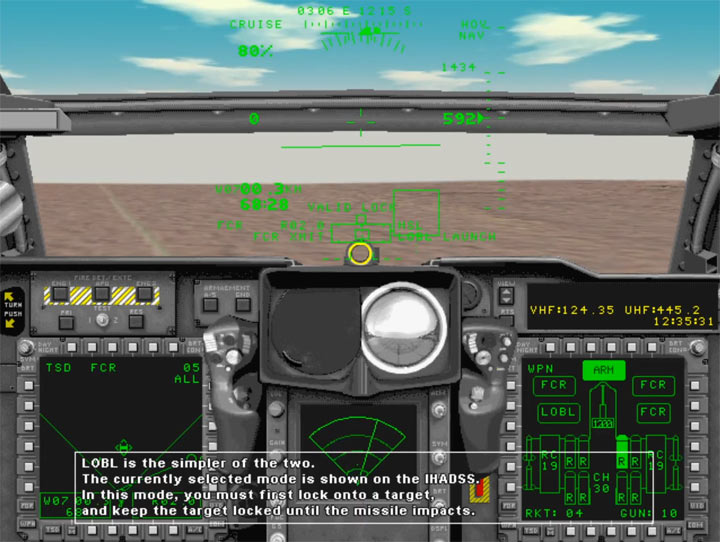
Enemy Engaged – Falcon BMS for helicopter fans
While sim fans were playing Longbow 2, in 1998 another Apache simulator was released under the name Enemy Engaged: Apache vs Havoc. It was not very hardcore, and players and critics emphasized that the game bridges the gap between arcade shooters and realistic sims. It was solid, had a very appreciated, dynamic campaign, but was in the end overshadowed by the sequel, Enemy Engagde: Comanche vs Hokum, which actually merged into a single game with its predecessor on the disc. The biggest event, however, was the publication of the sequel's source code, which allowed the community to create countless modifications and improvements, ensuring an exceptional longevity for the game, similar to the BMS modification for Falcon 4.0 released in 1998.
DCS: AH-64 - amazing quality leap
After Longbow 2, the world of simulators has forgotten about the Apache helicopter, although the genre itself has not stopped expanding. Today, we can notice one of the biggest quality leaps in the world of computer entertainment. Released 26 years after Jane’s AH-64D Longbow, and 36 years after the original Gunship, DCS: AH-64D Apache from Eagle Dynamics becomes the new benchmark of helicopter simulators. And judging by the fact that the game's servers got completely overwhelmed on release day, taking us back to download speeds from about 2001, the longing for the iconic Apache was substantial in the simulator fandom.
The first thing that catches the eye is practically photorealistic graphics. The model features almost every rivet and screw, not to mention details such as shells spitting out of the cannon and visible alterations in the rotor blades' angle. Inside, we can enjoy a fully three-dimensional cockpit, where you can freely look around and press virtually every button. Moreover, all the systems and information displayed on the cockpit screens, as well as the interface to operate them, work and look just like in the real heli.
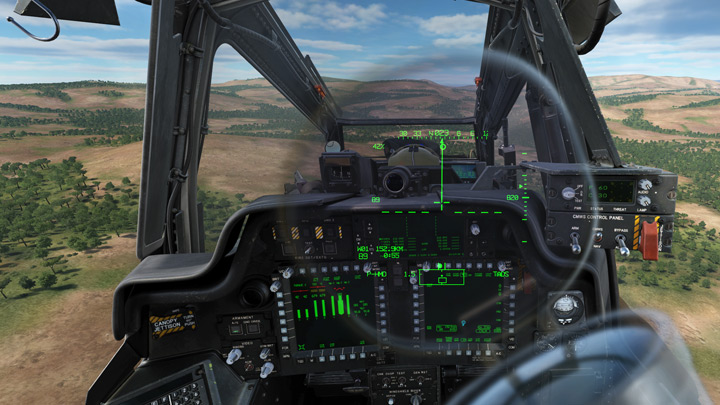
Now, there's no room for a sort of joyful creativity – inventing and adapting mechanics to make them more attractive to Sunday players or better adapted to computer capabilities. Modern equipment can do pretty much anything today, so the only thing that limits the creators is the level of confidentiality of the information they need. This is precisely the reason why modern simulators do not feature modern machines, but rather those that have been around for a few decades – you simply don't risk going to jail for releasing a realistic game. That's why Apache by Eagle Dynamics is model D, from around 2005-2010, and not the latest E version nicknamed Guardian.
The physics of the flight mechanics and the forces acting upon the helicopter during the flight also have a completely new quality. Already in earlier simulators, attempts were made to reflect the effects of the so-called airbag or autorotation, but only DCS: AH-64D allowed us to really feel what it's like to fly a helicopter. Also, forget about mouse and keyboard. You won't be able to do without a good joystick with dedicated throttle, and the set will also include pedals that are very important in helicopters. In addition, it's worth investing in a head tracker to fully enjoy the system of aiming the cannon with eyesight.
A mod worthy of being called a simulator
DCS: AH-64D Apache isn't exactly the first Apache simulator since Enemy Engaged. For the sake of accuracy, we should also mention mods for ARMA 2 and ARMA 3, carefully developed by the community of fans. In the latter, there were even interactive elements in the cockpit. The degree of fidelity to the simulation was of course much lower, but for a fan-made mod, the end result was exceptional. The sandbox itself is also important, especially in the third installment, as it allows helicopters to cooperate with infantry units and armored vehicles.
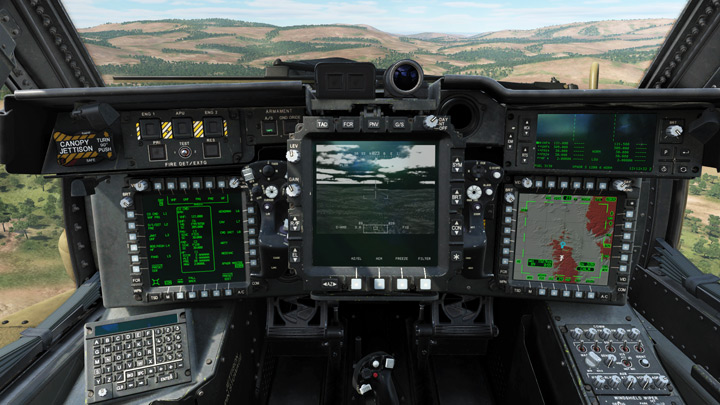
Experts instead of instructions
Fortunately, obtaining the right hardware is not a problem today. Although the genre of simulators has become a niche for enthusiasts, there has never been such a wide selection of controllers and components for home cockpits. If something's missing or is very expensive, home-grown inventors can create it with 3D printers, sharing their resources and experiences with others. And the hardware is just one of the issues showing how virtual flying has changed, not only in terms of quality and realism of the simulation itself.
Modern simulators are painfully realistic, and therefore difficult and not very accessible, but thanks to the Internet, dozens of videos with instructions and tips on what to do and how appear almost immediately after release. Even more interesting is how the role of military consultants has changed. In the past, there were only notes in Longbow 2 manual that the game was tested by and consulted with actual Apache pilots. Today, the role of the so-called SME (Subject of Matter Expert) is much closer to the ordinary user.
When developing DCS: Apache, many of them are also active DCS World users, so they tried to create a simulator they would enjoy themselves. Moreover, some of the ex-Apache pilots have their own YouTube channels, where they share their knowledge and insights directly – as much as they can without revealing classified stuff. They participate in debates and reply to comments, giving access to historically unprecedented level if insight. There's no way to compare this to the days of yore, where the sole source of information was the paper instruction booklet added to the game.
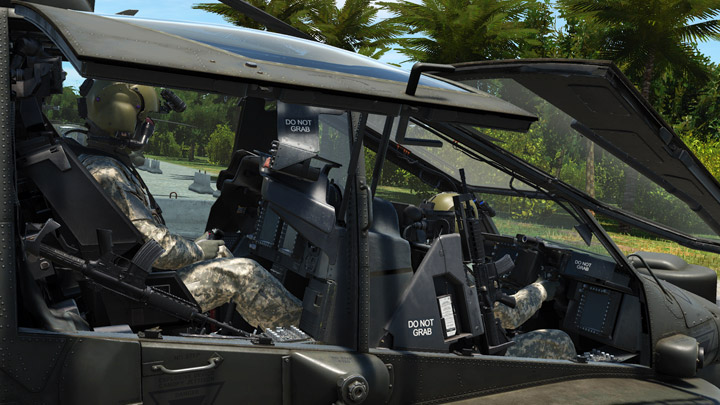
Not everything has changed for the better, though. Older simulators always brought dozens of missions, campaigns with engaging narratives, a sense of progressions, and even procedural missions that yielded endless hours of fun. Meanwhile, DCS World is just an open sandbox that entrusts players with organizing the fun and setting out goals on their own. Apache offers a few missions for starters, but compared to the old standards, it's only a fraction of the content, especially if you prefer single-player fun. This is partly the "charm" of unfinished productions available in early access, and partly a disadvantage on the part of DCS World sandbox itself, in which you have to pay extra for noteworthy campaigns, which additionally aren't well exposed in the game.
VR changes everything
AH-64D Apache from Eagle Dynamics shows the absolute precipice separating it from the old simulators in one more area – VR. It's difficult to describe the impressions you get from such a sesh, but it's probably valid to compare the difference between playing on regular monitor vs. in VR to playing Jane's Longbow vs. playing DCS: AH-64D Apache. Flying itself may not evoke any extreme emotions due to the relatively low speeds that the helicopter achieves, but the three-dimensional depth of the cockpit and the sense of correct scale of each element, and the machine as a whole, is truly stunning.
VR goggles practically teleport us to an authentic cockpit, allowing us to operate it like real pilots do. The level of immersion and atmosphere cannot be compared to anything – after all, it's hard to find a more suitable genre. VR seems perfect for games that involve sitting still and only moving the head, just like you do in the cockpit in real life. Simulators have achieved practically everything in terms of simulating the avionics and weapon systems – their future therefore ought to be about lighter VR goggles with even better field of view. And I venture to say that just as throttle joysticks have become a mandatory accessory of any fan of flight sims, the VR will soon become "the only correct way" to play them.
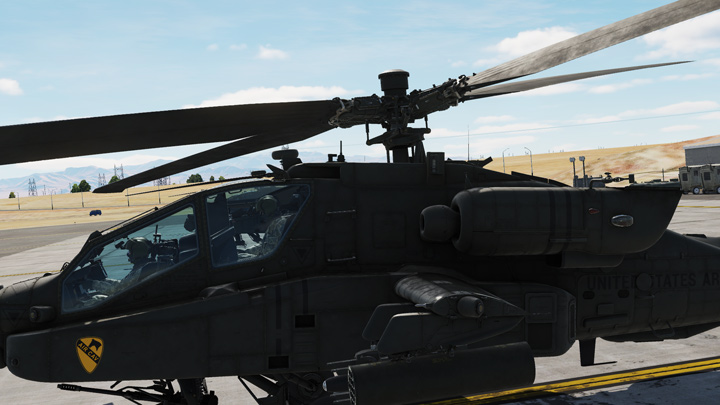
25 years? Worth the wait
If something can beat the Apache helicopter as a symbol of the evolution of the quality of graphics and simulation, as well as gameplay complexity, it could only be Cessna from Flight Simulator series by Microsoft. However, the Apache, armed to the teeth and a bit clumsy, is infinitely more badass, aggressive and provides incomparably greater, varied experiences than just flying from A to B. Gunship and Longbow are still noteworthy, evoking a lot of nostalgic emotions, but flight simulators today are more fun than they've ever been. More than a quarter of a century is a long time for a break in playing your favorite game, but the qualitative leap between DCS: AH-64D Apache and Longbow 2 makes up for all that time. It simply was worth the wait!
